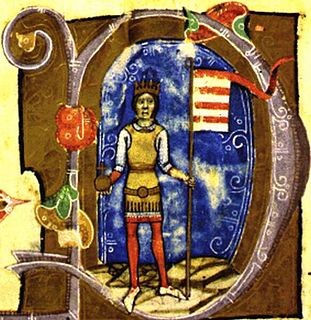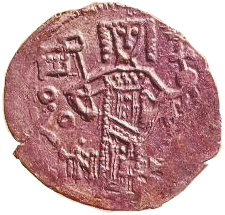 W
WDespot or despotes was a senior Byzantine court title that was bestowed on the sons or sons-in-law of reigning emperors, and initially denoted the heir-apparent of the Byzantine emperor.
 W
WAlexius Slav was a Bulgarian nobleman (bolyarin), a member of the Vlach Asen dynasty, a nephew of the first three Asen brothers. He was first probably the governor of the Rhodopes domain of the Second Bulgarian Empire, and then an autocrat in these lands.
 W
WBéla III was King of Hungary and Croatia between 1172 and 1196. He was the second son of King Géza II and Géza's wife, Euphrosyne of Kiev. Around 1161, Géza granted Béla a duchy, which included Croatia, central Dalmatia and possibly Sirmium. In accordance with a peace treaty between his elder brother, Stephen III, who succeeded their father in 1162, and the Byzantine Emperor Manuel I Komnenos, Béla moved to Constantinople in 1163. He was renamed to Alexios, and the emperor granted him the newly created senior court title of despotes. He was betrothed to the Emperor's daughter, Maria. Béla's patrimony caused armed conflicts between the Byzantine Empire and the Kingdom of Hungary between 1164 and 1167, because Stephen III attempted to hinder the Byzantines from taking control of Croatia, Dalmatia and Sirmium. Béla-Alexios, who was designated as Emperor Manuel's heir in 1165, took part in three Byzantine campaigns against Hungary. His betrothal to the emperor's daughter was dissolved after her brother, Alexios, was born in 1169. The emperor deprived Béla of his high title, granting him the inferior rank of kaisar.
 W
WJohn Komnenos Doukas, Latinized as Comnenus Ducas, was ruler of Thessalonica from 1237 until his death in 1244.
 W
WManuel Komnenos Doukas, Latinized as Ducas, commonly simply Manuel Doukas and rarely also called Manuel Angelos, was ruler of Thessalonica from 1230 to 1237 and, after his expulsion from Thessalonica, of Thessaly from 1239 until his death in c. 1241.
 W
WJohn II Megas Komnenos was Emperor of Trebizond from 1280 to 1297. He was the youngest son of Emperor Manuel I and his third wife, Irene Syrikaina, a Trapezuntine noblewoman. John succeeded to the throne after his full-brother George was betrayed by his archons on the mountain of Taurezion. It was during his reign that the style of the rulers of Trebizond changed; until then, they claimed the traditional title of the Byzantine emperors, "Emperor and Autocrat of the Romans", but from John II on they changed it to "Emperor and Autocrat of all the East, the Iberians, and the Transmarine Provinces", although Iberia had been lost in the reign of Andronikos I Gidos.
 W
WTheodore I Laskaris or Lascaris was the first Emperor of Nicaea—a successor state of the Byzantine Empire—from 1205 to his death. Although he was born to an obscure Byzantine aristocratic family, his mother was related to the imperial Komnenos clan. He married a younger daughter of the Byzantine Emperor Alexios III Angelos in 1200. He received the title of despot before 1203, demonstrating his right to succeed his father-in-law on the throne.
 W
WMichael VIII Palaiologos or Palaeologus reigned as the co-emperor of the Empire of Nicaea from 1259 to 1261, and as Byzantine emperor from 1261 until his death. Michael VIII was the founder of the Palaiologan dynasty that would rule the Byzantine Empire until the Fall of Constantinople in 1453. He recovered Constantinople from the Latin Empire in 1261 and transformed the Empire of Nicaea into a restored Byzantine Empire.
 W
WAndronikos Palaiologos or Andronicus Palaeologus was a Byzantine prince and the last Byzantine governor of Thessalonica with the title of despot (despotēs), from 1408 to 1423.
 W
WConstantine Doukas Komnenos Palaiologos was a Byzantine prince of the Palaiologos dynasty, who received the supreme title of Despot and served as provincial governor.
 W
WLeo Sgouros, Latinized as Leo Sgurus, was a Greek independent lord in the northeastern Peloponnese in the early 13th century. The scion of the magnate Sgouros family, he succeeded his father as hereditary lord in the region of Nauplia. Taking advantage of the disruption caused by the Fourth Crusade, he made himself independent, one of several local rulers that appeared throughout the Byzantine Empire during the final years of the Angeloi dynasty. He expanded his domain into Corinthia and Central Greece, eventually marrying the daughter of former Byzantine emperor Alexios III Angelos. His conquests, however, were short-lived, as the Crusaders forced him back into the Peloponnese. Blockaded in his stronghold on the Acrocorinth, he committed suicide in 1208.
 W
WMartino Zaccaria was the Lord of Chios from 1314 to 1329, ruler of several other Aegean islands, and baron of Veligosti–Damala and Chalandritsa in the Principality of Achaea. He distinguished himself in the fight against Turkish corsairs in the Aegean Sea, and received the title of "King and Despot of Asia Minor" from the titular Latin Emperor, Philip II. He was deposed from his rule of Chios by a Byzantine expedition in 1329, and imprisoned in Constantinople until 1337. Martino then returned to Italy, where he was named the Genoese ambassador to the Holy See. In 1343 he was named commander of the Papal squadron in the Smyrniote crusade against Umur Bey, ruler of the Emirate of Aydin, and participated in the storming of Smyrna in October 1344. He was killed, along with several other of the crusade's leaders, in a Turkish attack on 17 January 1345.